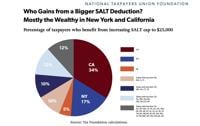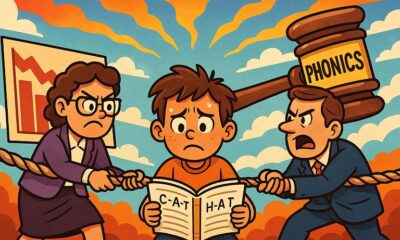News from the South - West Virginia News Feed
‘We’re drowning’: Teacher pay vs. cost of living approaches crisis level in WV’s Eastern Panhandle
‘We’re drowning’: Teacher pay vs. cost of living approaches crisis level in WV’s Eastern Panhandle
by Mike Chalmers, West Virginia Watch
March 10, 2025
The phrase “say the hard part out loud” has had a moment in the national spotlight recently. And within West Virginia, you’ll hear it repeatedly when you talk to education professionals in the Eastern Panhandle about teacher pay.
Something else you’ll hear with regularity is the word “crisis.”
Michelle Barnhart, a social studies teacher at Martinsburg’s South Middle School in Berkeley County, has seen the teacher shortage turn from a growing problem into something much more serious.
“When I started teaching in 2017, you had to be actively working on your degree to even be considered for a position. Now, they’re putting people with associate degrees — or no degree at all — into classrooms as full-time teachers,” she said. “They aren’t supposed to, but they have no choice.”
The state, added Barnhart, is ignoring the problem.
“Charleston doesn’t see it, or chooses not to. People downstate don’t understand that many of the adults in these kids’ classrooms up here aren’t actually teachers — because the teachers have gone elsewhere for better pay.”
Imagine, she said, if hospitals started hiring people with no medical background to be doctors. “Just pulling people off the street, handing them a clipboard, and saying, ‘Here, practice medicine.’ That’s what’s happening here in education.”
Barnhart said that many of her colleagues and fellow educators feel powerless at the end of the day.
“The cost of living in the panhandle is nowhere near the rest of West Virginia, but teachers, state workers — anyone whose salary is coded into law — get the same base pay. If you live elsewhere, that’s not a big deal. But if you move here, you suddenly realize this is a crisis.”
Parents, she said, are often unaware of just how bad the situation has become.
“They’ll see the bus driver shortage on the news and get outraged about routes being cut. But they don’t know what’s happening inside the classrooms. They don’t see how many positions go unfilled all year, or how often classes are just split up when a teacher calls out — overcrowding the ones that are already at their limit.”
Even for those who stay, Barnhart said, burnout is inevitable.
“You have algebra teachers covering trigonometry. English teachers covering history. Some days, they still can’t find someone to cover,” she said. “When that happens, learning just stops.”
Andrew Fincham, a health and physical education teacher at Martinsburg High School in Berkeley County, has seen the pattern repeat itself year after year.
“It’s only getting worse,” he said. “And with the population growth in the panhandle, we’re running out of room. Classrooms are overflowing, and we’re sticking kids in trailers to make it work — but the turnover rate with teachers is staggering.”
Currently, Berkeley County’s student population alone — at nearly 20,000 — exceeds the total population of 26 entire counties in West Virginia. As of the start of the current school year in August 2024, Berkeley County had nearly 200 permanent substitutes hired.
“We’re losing an alarming number of teachers every year throughout the county — whether it’s retirement or leaving for more money,” Fincham said. “And the impact on students is undeniable — all schools, all grade levels.”
Fincham doesn’t see the “revolving door” getting any better without major policy changes.
“All the nearby states — Virginia, Maryland, Pennsylvania — adjust salaries based on cost of living. West Virginia doesn’t. It’s easy to see where this is headed. If the state doesn’t start thinking about this in a new way, in five years, it’ll be catastrophic.”
The impact on retention, added Barnhart, can’t be overstated.
“Berkeley and Jefferson counties, especially, have become steppingstones. Teachers come here, get a few years of experience, and then leave for better pay — often nearby.”
For Barnhart, the predicament is both personal and professional. “I have kids in this school system; I see it as a parent and as an educator,” she said. “It’s frustrating because I don’t want to leave, but at some point, I might not have a choice.”
Considering almost all those choices are within 30 minutes or less, Barnhart admitted it’s hard to ignore the disparity.
“If I left for Frederick County Schools [Virginia], I’d make over $6,400 more per year,” she said. “In Washington County [Maryland], over $11,500 more. And Loudoun County [Northern Virginia], almost $25,000 more.”
The numbers don’t lie
At the end of the day, however, this isn’t a new conversation for people like Barnhart, Fincham, and thousands of others within the region. In recent decades, West Virginia’s education landscape has been punctuated by significant teacher strikes, notably in 1990 and 2018 — both primarily driven by concerns over inadequate compensation and escalating health care costs.
The 2018 strike, in particular, saw approximately 20,000 educators and school personnel shutting down schools across all 55 counties, culminating in a 5% pay raise for all state workers.
And yet, in 2025 — as in most years previous — West Virginia sits either dead last nationally or perilously close to dead last on just about any average teacher salary list you come across — jostling for position between Florida, South Dakota and Missouri year after year. Be that as it may, according to the most recent data available from the National Education Association, the estimated national average annual salary for teachers sits at $71,699 — while West Virginia shuffles in at $53,336.
That said, the Eastern Panhandle’s three core counties — Berkeley, Jefferson and Morgan — are the fastest-growing in the state, and closest to the Washington, D.C., metropolitan area, making them highly susceptible to issues like cost-of-living disparities and teacher-pay inequities.
According to the most recent data from the West Virginia Department of Education, the average annual teacher salary in Berkeley County lands at $55,412; the average for Jefferson County comes in at $54,153; and Morgan County sits at $55,624.
Compare that to West Virginia’s poorest county, McDowell, where the average teacher salary is $53,296. However, the average home value in McDowell County hovers around $35,000 — with the median home sale price standing at approximately $41,000. Accordingly, almost all cost-of-living data is lower or significantly lower in McDowell County. To that end, $53,296 goes a long way there, as it does in numerous other counties in West Virginia that boast similar cost-of-living data.
By contrast, average home values in Berkeley County climb into the $335,000-plus range. In Jefferson County, it’s even higher, with values exceeding $380,000. In Morgan County, values can exceed $350,000. The cost of living within these three counties is commensurate with those values. But the average teacher salary within the Eastern Panhandle comes in at $55,063 — not even $2,000 more annually than West Virginia’s poorest county.
Talk to anyone close to this issue, and they will tell you in no uncertain terms — it’s becoming all but impossible to work as a teacher or education service worker in the Eastern Panhandle and pay the bills. And when extra money does arrive, it’s in the form of a statewide raise — without consideration for locality pay — which keeps that allotment relatively small in proportion to the ever-widening economic gap between the Eastern Panhandle and the rest of the state.
Bargaining power
“It’s economics 101,” said John Deskins, director of West Virginia University’s Bureau of Business and Economic Research. “If salaries remain the same across the state, schools in more competitive job markets like the Eastern Panhandle will struggle to attract and retain teachers. It’s a matter of supply and demand — higher costs and a stronger labor market require higher pay.”
Berkeley County Schools Superintendent Ryan Saxe, formerly superintendent in Cabell County, echoed the sentiment — and admitted to not fully grasping the depth of the problem until taking his current job.
“In my previous county, we competed with Ohio and Kentucky for teachers, but the disparity wasn’t nearly as severe as what we see here with Maryland and Virginia,” he said.
Saxe doesn’t believe West Virginia needs to match those salaries dollar for dollar, “… but we must close the gap,” he said. “Right now, we have around 200 permanent substitute positions because we can’t fill them with certified staff. That depletes our substitute pool and leaves us constantly reposting vacancies for high-need areas.”
Sen. Patricia Rucker, R-Jefferson, believes part of the issue is Charleston’s reluctance to even acknowledge cost-of-living disparities.
“The federal government has already done the research to determine appropriate salary increases for employees based on regional economic conditions,” she said. “A similar approach for public employees in high-cost areas in our state makes sense.”
But the push for locality pay has failed repeatedly, she said, primarily due to opposition from lawmakers outside the Eastern Panhandle.
“The Senate has passed similar measures three times, only for them to fail in the House,” Rucker said, “The last time, we were 14 votes short. That’s a big gap.”
The resistance comes from a long-standing belief in uniform pay across all 55 counties, said Dale Lee, president of the West Virginia Education Association.
“But that resistance mindset ignores an economic reality,” Lee said. “A few years ago, an attempt to secure locality pay for state police was soundly defeated. The challenge is that while it would benefit a few counties, the majority wouldn’t see any advantage — so their delegates aren’t inclined to support it.”
Instead of direct locality pay, some legislators are exploring alternatives, like reducing the “local share,” which would allow high-growth counties to keep more of their tax revenue to fund education salaries.
“If that money is earmarked for salaries and benefits, it could be a real solution,” Lee said.
As Lee indicated, the shortage isn’t limited to teachers — state police, social workers and other public employees face the same problem in high-cost areas.
Former West Virginia delegate John Doyle has been advocating for locality pay for over 30 years, first proposing a housing allowance in the early 2000s as a way to soften opposition.
“The state would provide a housing allowance based on cost-of-living data,” he said. “Every county would be ranked from 1 to 55, with the median county serving as the baseline. Any county ranked above the median would receive some level of housing allowance — smaller for those just above, larger for the highest-cost counties.”
He recalled that when cost-of-living data was first released to legislators, some were stunned by the housing prices in the Eastern Panhandle. “They assumed we all lived in large homes. I had to explain that I lived in a 1,000-square-foot FHA rancher, and it was worth almost double the state average.”
Doyle also warned against the idea that raising salaries in border counties would simply cause a ripple effect of teacher migration.
“Salaries don’t need to match Maryland and Virginia — just get close enough. If the gap is $20,000, they’ll leave. If it’s $10,000 or less, they might stay.”
But the state has spent decades failing to act. Doyle pointed out that in 1990, West Virginia was ranked 26th in teacher pay after a major statewide raise under former Gov. Gaston Caperton. By the late 1990s, Maryland and Virginia had surged past it once again.
“Every few years, the issue reaches a boiling point, like the 2018 teacher strike, which resulted in a 5% statewide raise — but failed to address the Eastern Panhandle’s unique economic challenges,” he underscored.
With legislative momentum reliably sluggish, greater political action might be required, said Rucker — who also chairs the Government Organization Committee.
“If we don’t have enough qualified teachers, we are failing to meet our constitutional obligation to provide an efficient education system. A class action lawsuit could force the state’s hand,” she said.
On the economic side, Deskins sees another consequence of inaction: economic decline.
“If schools decline due to this crisis, the region becomes far less appealing. People don’t want to move to areas with struggling schools, which would ultimately slow economic growth,” Deskins said.
Essentially, explained Deskins, West Virginia’s fastest-growing region — the only part of the state successfully attracting new residents — is being left to fend for itself.
“From a broad economic-development perspective, we’re making one of the state’s most promising regions less attractive — ultimately working against ourselves,” Deskins said.
The political fight will only continue, and will hopefully play a prominent role in the current legislative session, said Doyle — who believes the Eastern Panhandle finally has strength in numbers.
“The Eastern Panhandle now has more than 10% of the legislature,” Doyle said. “That gives our delegation real bargaining power. If they unify and make this a non-negotiable priority, they can trade support on other bills to get it passed.”
Rucker agreed.
“The delegates from this region have better strength in numbers, and are working hard to educate their colleagues and emphasize that this benefits the entire state, not just the Panhandle,” she said.
Nonetheless, Lee remains skeptical.
“In my experience, when the legislature makes something a priority, they find the money for it,” he said. “If this becomes a priority, a solution will follow. But that remains to be seen.”
Doyle, however, was more blunt: “At the heart of it all is the fact that the state doesn’t want to give money to teachers because they want to be able to give a giant tax break to corporations.”
Repeated requests for comment from State Superintendent of Schools Michele Blatt went unanswered.
The cost of inaction
Imagine a moment in the near future in the Eastern Panhandle — likely Berkeley or Jefferson Counties — when a brand-new high school opens with all the pomp and circumstance that comes with such occasions. And on day one, as the doors open and the students pour through them en route to homeroom and the new year ahead, not a single certified teacher is there to greet them. Rather, every room, and every subject, is being covered by a substitute.
Sounds crazy? Many education professionals in the Eastern Panhandle are calling it something else: inevitable.
“I can easily see that happening — we’re drowning,” said Jana Woofter, a chemistry and physical science teacher at Spring Mills High School in Martinsburg. Woofter also serves as president of the Berkeley County Education Association.
“Bills are often triple what they are in other parts of the state,” she said. “Housing costs are through the roof. Berkeley County tries to help with a housing allowance, but Jefferson and Morgan counties don’t have those same benefits. Even with the assistance, my members are struggling — especially with PEIA [West Virginia’s Public Employees Insurance Agency] costs rising.”
The struggle isn’t just with the state. Clay Anders, a physical education teacher at C.W. Shipley Elementary in Jefferson County’s Harpers Ferry, is frustrated that even as property values have doubled, teachers haven’t seen a county-based raise in over a decade.
“The local levy passed again, and there’s millions in additional revenue coming in — but none of it has gone to us in quite a while,” he said. “Meanwhile, the board office has added new positions and given themselves raises every year.”
As of Nov. 6, 2024, the Jefferson County School Excess levy passed with ease — totaling $25,427,656. According to Jefferson County Schools, the bulk of the levy — $19,376,035 — will go to “salary assistance for teachers and service personnel.”
At the same time, Anders pointed out, extra-pay options that once existed for Jefferson County educators have disappeared.
“The county cut a program that allowed teachers to earn up to 3,000 extra dollars per year. That was real money that made a difference. But then they phased it down to $1,500, and now it’s gone completely.”
The level of participation in that program told him everything he needed to know.
“Nearly 98% of eligible teachers took part in it,” Anders said. “That should tell you how much we need the money.”
He believes that if the county won’t act, teachers may have to take matters into their own hands.
“Maryland and Virginia have county-based unions that fight for local pay,” Anders said. “West Virginia doesn’t. We only have state-level unions, and they aren’t fighting county battles.”
Additionally, Anders and a group of teachers are preparing a Freedom of Information Act request to uncover exactly where the money is going.
“The board claims there’s no money for teacher raises, yet they’re increasing salaries at the top. If every million dollars in new revenue could mean an $800 to $900 raise per teacher, then where is that money going?”
The answer, at least in Berkeley County, according to Board of Education member Damon Wright, is complicated.
“Most of our budget already goes to salaries,” Wright said. “And we’ve denied requests for new administrative positions to keep costs down. But we continue to have growth needs — especially when it comes to mental health services for students, which require more funding.
“That said, every time we dip into reserves, we run the risk of the state stepping in and questioning our financial management. We’ve increased the housing allowance, and we’ll keep looking for ways to supplement pay, but we can’t solve this alone.”
The challenges only get more complex, he said, when Charleston refuses to act.
“The state doesn’t believe in cost-of-living adjustments. They think if we raise salaries in high-cost areas like the panhandle, teachers from rural counties will flood the region. But that’s not realistic. Most teachers in McDowell and similar counties are among the highest-paid professionals in their communities. Here, teachers need roommates just to afford rent.”
Michelle Pereschuk, a special education teacher at South Middle School, called the system broken and confessed that teachers are running out of reasons to stay — including herself.
“I’ve been at the tipping point for years,” she said. “I was born and raised in Berkeley County. My kids are in the school system. I want to stay — but I can’t afford it much longer.”
Like many in the county, Pereschuk’s mortgage swallows her paycheck. She once considered a position in nearby Washington County, Maryland, that would have paid her $11,000 more in the first year and up to $17,000 more over time. She ultimately stayed due to personal reasons, but the pull to leave grows stronger every day.
“Winchester City Schools and Frederick County, [both in Virginia], are 20 minutes from my house. Maryland and Virginia also allow out-of-state teachers to send their kids to school there. For the first three years, you pay a small tuition fee, then your kids attend for free. If I move, I could take my youngest with me and give him a better-funded education while making a lot more money.”
Such decisions aren’t just being measured in Pereschuk’s household, she assured, but rather, in many homes across the region.
“Off the top of my head, I can name at least 10 people in my school alone who are seriously considering leaving,” she said.
Woofter, who works multiple jobs to make ends meet, added that, even for those who choose to stay, survival requires sacrifices.
“I run the science fair for my school and the county, coordinate academic competitions, tutor, sell tickets at events — anything to make extra money. If I moved across the border, I wouldn’t have to do all that. But I stay because I love it here.”
As for rising insurance costs, Wright said, whatever raises the state offers at this point are quickly wiped out by PEIA increases.
“The misconception is that a raise actually means more money,” he said. “It doesn’t. When insurance premiums jump 40%, and co-pays triple, as they’re set to do, it’s actually a pay cut. Later this summer, when those PEIA increases hit, I think we’ll see a mass exodus — not just teachers, but public employees across the board.”
Without action, warned Woofter, the situation will only deteriorate. She’s already seeing it play out at her own school.
“Spring Mills High School opened in 2013. In just over a decade, fewer than 20 original staff members remain. That kind of turnover is devastating.”
Moreover, Wright said, Charleston’s inaction is feeding into another, larger movement — the privatization of education.
“Rather than addressing the crisis in public schools, the state is using the decline as an excuse to push private schools, charter schools and voucher programs,” he said. “The problem is, 25% of Berkeley County’s students have special needs, and public schools are required to serve them — private schools are not.”
West Virginia doesn’t fully fund those services so counties cover the gap.
“If lawmakers shift funding away from public schools to private options, that burden grows,” Wright said. “They’re letting the system fail so they can justify alternatives.”
At the end of the day, he said the community is the last line of defense.
“We’re already in crisis mode — whether the state chooses to address it or not. The public needs to understand just how bad this is getting. And the only way any of this changes is if the public demands it — loudly. If people in the panhandle make enough noise, Charleston can’t ignore it forever.”
YOU MAKE OUR WORK POSSIBLE.
West Virginia Watch is part of States Newsroom, a nonprofit news network supported by grants and a coalition of donors as a 501c(3) public charity. West Virginia Watch maintains editorial independence. Contact Editor Leann Ray for questions: info@westvirginiawatch.com.
The post ‘We’re drowning’: Teacher pay vs. cost of living approaches crisis level in WV’s Eastern Panhandle appeared first on westvirginiawatch.com
News from the South - West Virginia News Feed
Company preserving WV's past with reclaimed wood
SUMMARY: Barewood Company in Hurricane, West Virginia, started 11 years ago by owner Matt Snider, a woodworker with 30 years of experience. He left a stable job to create a business using reclaimed wood from local historic sites. One notable piece came from a barn in Hamlin, which remained unchanged despite shifts in county and state lines. Barewood crafts products from wood sourced from old businesses, barns, and even bowling alleys, incorporating live edge, epoxy, and bourbon barrel heads. With locations in Hurricane, Charleston, and Morgantown, the company preserves West Virginia’s history through its unique, story-rich wooden creations.

PUTNAM COUNTY, W.Va. (WCHS) — In a sawdust-filled building in Hurricane, West Virginia, you find Bear Wood Company — an idea that started 11 years ago in a garage.
Owner Matt Snyder said he has been a woodworker for about 30 years, but took a leap in making it his full-time career.
_________________________________________
For the latest local and national news, visit our website: https://wchstv.com/
Sign up for our newsletter: https://wchstv.com/sign-up
Follow WCHS-TV on social media:
Facebook: https://www.facebook.com/eyewitnessnewscharleston/
Twitter: https://twitter.com/wchs8fox11
Instagram: https://www.instagram.com/wchs8fox11/
News from the South - West Virginia News Feed
FEMA’s refusal to help some West Virginia counties just a taste of what’s to come
by Leann Ray, West Virginia Watch
April 29, 2025
Last week, West Virginia Watch reporter Amelia Ferrell Knisely traveled to McDowell County to talk to residents about recovery efforts after the mid-February floods.
She found that many people still have soggy carpets and wet basements after more than two months. Houses are filled with mold. Trash is piled up outside. Some residents say they haven’t seen anyone from the state or federal government in their small towns offering help.
And McDowell is one of the few counties that actually received federal funding for flood response.
In late February, the federal government approved Gov. Patrick Morrisey’s request for federal aid. The Federal Emergency Management Agency has so far approved nearly 3,500 applications for individual assistance, and more than $25 million has been awarded to residents in Logan, McDowell, Mercer, Mingo, Raleigh, Wayne and Wyoming counties.
Residents who receive that money can use it to cover the costs of temporary housing and home repairs.
About 94% of West Virginia communities are considered “Special Flood Hazard Areas,” which means the more than 84,000 structures in those areas are at a high risk of flooding, according to a 2023 report by researchers at West Virginia University.
However, President Donald Trump has suggested that FEMA, which is the only agency currently that administers disaster relief funds, might “go away.”
Last week it was announced that Elon Musk’s Department of Government Efficiency would cut 1,000 employees — or 20% of the workforce — from FEMA, just ahead of hurricane season.
On Wednesday, Morrisey announced that FEMA denied individual assistance grants to Boone, Cabell, Greenbrier, Kanawha, Lincoln, Monroe and Summers counties, and public assistance grants in Cabell and Kanawha counties for the February floods.
“Despite today’s notification, I am grateful to the Trump Administration for their strong support for Southern West Virginia’s recovery following the February floods,” Morrisey said in a statement.
We know you’re not a native West Virginian, governor, but please stand up for your adopted state.
Alex Brown from Stateline, one of West Virginia Watch’s sister newsrooms, reached out to the White House about states being denied FEMA funding, and received a statement that said the agency is focused on “truly catastrophic disasters,” and that states need to have a better “appetite to own the problem.”
West Virginia has no appetite, as shown during the legislative session.
On April 4, about three weeks after the devastating February floods, Del. Sean Hornbuckle, D-Cabell, proposed adding $50 million to the state budget for flood prevention.
“We have the ability to do something earthly,” Hornbuckle said. “The power that we have — not just the divine power — but with a button and a pen that we all have to help out neighbors in the great state of West Virginia.”
The amendment was rejected 75-19.
Remember the 2016 floods — the deadliest in the state’s history? Former Gov. Earl Ray Tomblin, a Democrat born in Logan County, declared a state of emergency for 44 of the state’s 55 counties.
Since November 2019, FEMA has given West Virginia more than $424 million in funding in response to the 2016 floods. More than $42 million was given to 4,949 individuals and families, and more than $172.8 million was given to local and state governments and some nonprofits. FEMA also provided more than $209.8 million to replace Herbert Hoover High, Richwood Middle, Richwood High, Summersville Middle and to relocate Clendenin Elementary.
Herbert Hoover High School was destroyed, and students were taught in portable classrooms until their new school was completed in fall 2023. Clendenin Elementary School didn’t reopen until fall 2024. Construction hasn’t started on the schools destroyed in Nicholas County.
In response to that flood, the West Virginia Legislature created the State Resiliency Office. Its purpose is to “Minimize the loss of life and property, maintain economic stability, and improve recovery time by coordinating with stakeholders to implement disaster resilient strategies.
The state Legislature created the West Virginia Disaster Recovery Trust Fund in 2023 with Senate Bill 677. The fund sits empty. No money was allocated to that fund during the 2024 legislative session. The FY 2026 budget, which Morrisey has signed, doesn’t include any money for the fund either.
There were only three bills related to flooding during the session — House Bill 2858 and Senate Bill 502 were the same bill, meant to allow counties to regulate floodplains under National Flood Insurance Program guidelines. They both died. House Bill 3502, sponsored by Hornbuckle, would have allowed a one-time allocation of $100 million from the state revenue shortfall fund and $150 million from the state’s income tax revenue fund for the West Virginia Flood Resiliency Trust Fund. It died in the House Government Organization.
West Virginia needs FEMA, but with FEMA potentially out of the picture, it’s time the state whet its appetite and take a bite out of the problem.
Morrisey has already said he plans to call a special session this summer to deal with the Public Employees Insurance Agency and education funding. Sounds like the perfect time and a good use of tax payer money to move some funding over to the West Virginia Disaster Recovery Trust Fund.
GET THE MORNING HEADLINES.
West Virginia Watch is part of States Newsroom, a nonprofit news network supported by grants and a coalition of donors as a 501c(3) public charity. West Virginia Watch maintains editorial independence. Contact Editor Leann Ray for questions: info@westvirginiawatch.com.
The post FEMA’s refusal to help some West Virginia counties just a taste of what’s to come appeared first on westvirginiawatch.com
Note: The following A.I. based commentary is not part of the original article, reproduced above, but is offered in the hopes that it will promote greater media literacy and critical thinking, by making any potential bias more visible to the reader –Staff Editor.
Political Bias Rating: Center-Left
This content reflects a center-left political bias as it highlights government and federal aid shortcomings in disaster response and recovery, particularly criticizing Republican leadership and policies, such as those associated with former President Trump and West Virginia Governor Morrisey. It underscores the need for more proactive state intervention and funding to support vulnerable communities, especially in the context of disaster resilience. The critique of budget decisions and FEMA staff cuts aligns with a perspective that supports stronger public sector involvement and social responsibility, typical of center-left viewpoints, without veering into extreme or partisan language.
News from the South - West Virginia News Feed
Couple sentenced in historic human trafficking case intend to appeal convictions
SUMMARY: Jeannie White Feather and Donald Lance, sentenced to over 100 years for human trafficking and related charges, are set to appeal their convictions. During a recent court hearing, their defense attorneys indicated intentions to seek a higher court review due to possible legal errors. While the appeal process is underway, two minor misdemeanor charges for false swearing were dismissed since their sentences are already severe. The case, notable for being the first successful human trafficking prosecution in the state, originated from the discovery of their adopted children living in deplorable conditions.

Jeanne Whitefeather and Donald Lantz appeared virtually from prison in their first hearing since they were each sentenced to more than 100 years in prison, but as it was pointed out in court, the clock is ticking for them to appeal their case.
FULL STORY: https://wchstv.com/news/local/couple-sentenced-in-historic-human-trafficking-case-intend-to-appeal-convictions
_________________________________________
For the latest local and national news, visit our website: https://wchstv.com/
Sign up for our newsletter: https://wchstv.com/sign-up
Follow WCHS-TV on social media:
Facebook: https://www.facebook.com/eyewitnessnewscharleston/
Twitter: https://twitter.com/wchs8fox11
Instagram: https://www.instagram.com/wchs8fox11/
-

 Mississippi Today3 days ago
Mississippi Today3 days agoTrump appoints former Gov. Phil Bryant to FEMA Review Council as state awaits ruling on tornadoes
-

 News from the South - Missouri News Feed5 days ago
News from the South - Missouri News Feed5 days agoMissouri lawmakers on the cusp of legalizing housing discrimination
-

 Mississippi News6 days ago
Mississippi News6 days agoEvents happening this weekend in Mississippi: April 25-27
-

 Mississippi Today4 days ago
Mississippi Today4 days agoDerrick Simmons: Monday’s Confederate Memorial Day recognition is awful for Mississippians
-

 Mississippi Today7 days ago
Mississippi Today7 days agoTyler Perry comedy about a Mississippi lieutenant governor ‘She The People’ set to stream on Netflix
-

 News from the South - Florida News Feed6 days ago
News from the South - Florida News Feed6 days agoFlorida woman accused of setting fires during burn ban
-

 News from the South - North Carolina News Feed3 days ago
News from the South - North Carolina News Feed3 days agoAppointment power for election boards remains with NC governor
-

 Mississippi Today7 days ago
Mississippi Today7 days agoParents, providers urge use of unspent TANF for child care







































